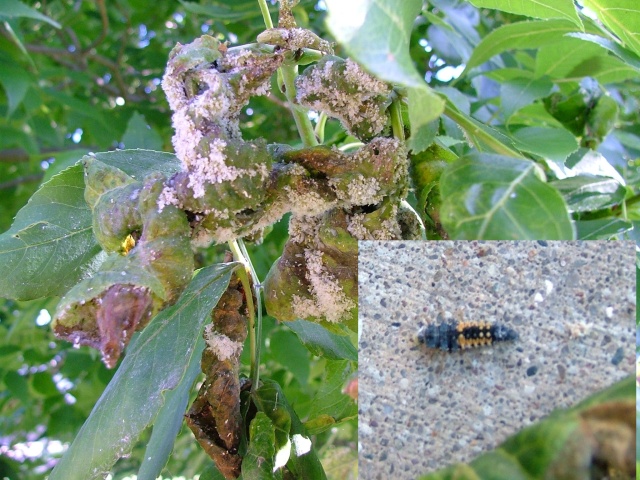Question Ash tree bug and leaf
Ash tree bug and leaf
QUESTION: I have an unknown (to me) insect on my green ash tree. It does not look like pictures I have seen of the Emerald Ash borer. It is causing damage to the leaves, they are curling and are sticky. I have attached a picture of the leaves and the insect. Thanks.
ANSWER: Looks like the Brownheaded Ash sawfly, Tomostethus multicinctus .
Larvae damage ash trees by chewing the leaves in May and early June. The larvae are pale green "worms" with some light banding. During outbreaks, they extensively defoliate the tree. This can cause serious stress, particularly when it occurs repeatedly. The worms can also be a nuisance when they wander from the tree and move to areas of loose soil, where they overwinter.
The brownheaded ash sawfly spends the winter as a full-grown larva within a cocoon in soil around the base of previously infested ash trees. Pupation occurs in early spring. Adults are small, black, nonstinging wasps that typically emerge by late April.
During warm days, swarms of the wasps may appear around trees as they mate and lay eggs. The eggs are inserted into the edge of expanding leaves. This usually results in a slight distortion of the leaves.
Young larvae feed on the interior of leaves, producing small pinhole feeding wounds. As they get older, they feed extensively on leaves, avoiding only the main veins. During the late stages of development, defoliation can progress rapidly. However, injuries also subside quickly, as the insects usually become full-grown within two to three weeks after egg hatch.
During most years, the larvae are active during May. They become full-grown by early June. Full-grown larvae shed a papery larval skin that remains attached to the leaf. They crawl to the soil, where they form protective cocoons. There is one generation per year. The larvae remain in the cocoons until the following season.
There are several considerations when deciding whether to control brownheaded ash sawflies. Established, healthy trees tolerate defoliation fairly well, particularly if it occurs infrequently. Trees benefit from control only if the insects threaten to remove at least 25 percent of the foliage. Trees that are repeatedly heavily defoliated, are in marginal health, or are suffering from other important stresses (e.g., bark beetles, borers, scale) will benefit most from treatment.
The larvae form is a wek link in the life cycle and can be easily killed. They are susceptible to most garden insecticides (e.g., carbaryl/Sevin, chlorpyrifos/Dursban, permethrin, malathion). These should be sprayed on the insects themselves since these are contact insecticides. Since these insects are not one of the caterpillar type insects ,Bacillus thuringiensis (Dipel, Thuricide) and neem do not appear to be effective.
---------- FOLLOW-UP ----------
QUESTION: I considered the sawfly but was bothered by the fact the insect itself looks nothing like any picture I found of any version of a sawfly adult or larvae. Also, I don't really see holes in the leaves, just curled, damaged, sticky leaves covered with white material that now seems dried and fluffy. Originally, the material seemed to be full of alive wrigglings things (excuse the non-technical description) but now it is just dry.
AnswerThe leaf pictures look like the feeding of saw fly but the insect looks like the larvae of a lady bug beetles which feeds on other insects like aphids and could feed on small sawflies. I still think the damage was from sawflies and the lady bigs are secondary and not causing any damage to the tree.






